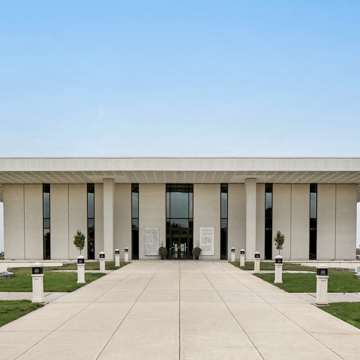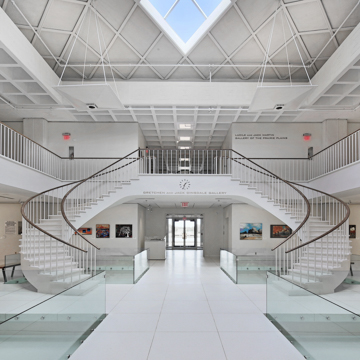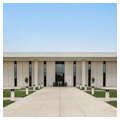Designed by Edward Durell Stone, the Stuhr Museum of the Prairie Pioneer is named after Leo Stuhr, a farmer and politician whose family was early pioneers. The museum’s collection began with his donation of land, funds, and artifacts, and its intention is to preserve and display the historical legacy of the pioneer communities in the state of Nebraska. The museum forms the centerpiece of the reconstructed Railroad Town, which surrounds the museum and depicts early life on the prairie during the late 1800s. Railroad Town contains a variety of buildings including several shops, a school, a church, a farmstead, a Pawnee earth lodge, and numerous dwellings, including the house in which actor Henry Fonda was born in 1905.
Stone’s modernist design is typical of his work during the mid-twentieth century. Built in 1963, the Stuhr Museum has architectural precedence in two of Stone’s widely publicized commissions: the United States Embassy in New Delhi, India (1954), and the United States Pavilion at the 1958 International Exposition in Brussels, Belgium. In Grand Island, the two-story museum building is square in plan and set on a plinth sited on a round island in a round, man-made lake. Constructed of concrete masonry units and poured-in-place concrete, it is plastered with Granulux, a textured plaster mix with marble chips. Wrapped on all four sides with a portico, the building has a pronounced flat roof punctured by a pyramidal skylight that allows ample light into the center of the building. There are two entrances on the north and south. The interior contains a center gallery on the main level with four square pools with fountains, and a monumental stair to the open second floor.
In 2014 the Lincoln-based BVH Architecture began an extensive renovation of the museum, which was unchanged from the time of its completion. Their work follows the Secretary of the Interior Standards for Rehabilitation to restore as much as possible, and where changes are necessary, to make them as unobtrusive as possible with respect for the original architectural intentions. This renovation includes the abatement of hazardous materials, compliance with the Americans with Disabilities Act and Life Safety Code, the addition of insulation and a new roofing member, and updated finishes throughout the building, as well as replacement of the exterior Granulux and all windows. The museum’s primary use remains but it can now accommodate larger social functions with an expanded kitchen and the addition of a new stair leading from the plinth to the lawn on the east side to accommodate outdoor events. The museum reopened in summer 2015.
References
Hunting, Mary Anne. Edward Durell Stone: Modernism's Populist Architect. New York: W. W. Norton, 2013.
Stone, Edward Durell. Edward Durell Stone: Recent and Future Architecture. New York: Horizon Press, 1967.

















